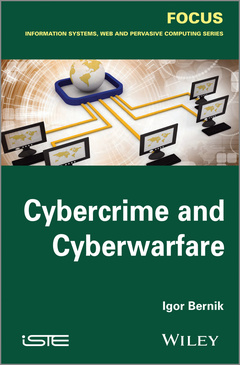Description
Cybercrime and Cyber Warfare
Author: Bernik Igor
Language: English
Subject for Cybercrime and Cyber Warfare:
Keywords
introduction; cybercrime; perpetrators; motives; offenders; implementing attacks; tools; attacks; fear; investigation; cost; model; framework
176 p. · 16.3x24.1 cm · Hardback
Description
/li>Contents
/li>Biography
/li>
The first chapter focuses on the understanding of cybercrime, i.e. the perpetrators, their motives and their organizations. Tools for implementing attacks are also briefly mentioned, however this book is not technical and does not intend to instruct readers about the technical aspects of cybercrime, but rather focuses on managerial views of cybercrime. Other sections of this chapter deal with the protection against attacks, fear, investigation and the cost of cybercrime. Relevant legislation and legal bodies, which are used in cybercrime, are briefly described at the end of the chapter.
The second chapter deals with cyberwarfare and explains the difference between classic cybercrime and operations taking place in the modern inter-connected world. It tackles the following questions: who is committing cyberwarfare; who are the victims and who are the perpetrators? Countries which have an important role in cyberwarfare around the world, and the significant efforts being made to combat cyberwarfare on national and international levels, are mentioned.
The common points of cybercrime and cyberwarfare, the methods used to protect against them and the vision of the future of cybercrime and cyberwarfare are briefly described at the end of the book.
Contents
1. Cybercrime.
2. Cyberwarfare.
About the Authors
Igor Bernik is Vice Dean for Academic Affairs and Head of the Information Security Lab at the University of Maribor, Slovenia. He has written and contributed towards over 150 scientific articles and conference papers, and co-authored 4 books. His current research interests concern information/cybersecurity, cybercrime, cyberwarfare and cyberterrorism.
Introduction vii
Acknowledgement x
Chapter 1. Cybercrime 1
1.1 The perpetrators of cybercrime 22
1.2 Tools for implementing attacks 31
1.3 System protection against attacks 32
1.4 Fear of cybercrime 34
1.5 Investigation of cybercrime 37
1.6 Cost of cybercrime 39
1.7. The Council of Europe Convention on Cybercrime 49
1.8. Cybercrime conclusion 55
Chapter 2 Cyberwarfare 57
2.1. Information and cyberspace 60
2.2. Understanding cyberwarfare 67
2.3. Perpetrators and victims of cyberwarfare 80
2.4. Committing cyberwarfare 82
2.5. Organizations and cyberwarfare 95
2.6. The role of countries in cyberwarfare 107
2.7. Efforts against cyberwarfare: international and national legislation 123
2.8. Defense against cyberwarfare 133
2.9. Cyberwarfare conclusion 139
Conclusion 141
Bibliography 145
Index 163




